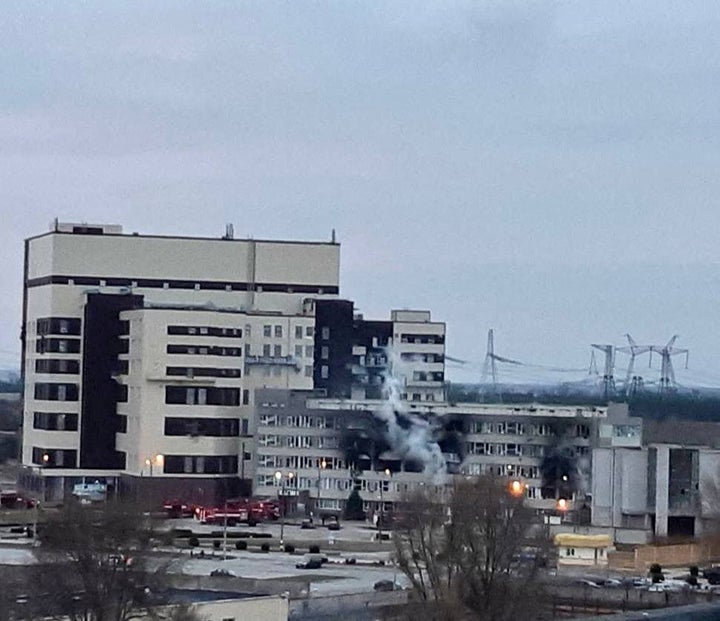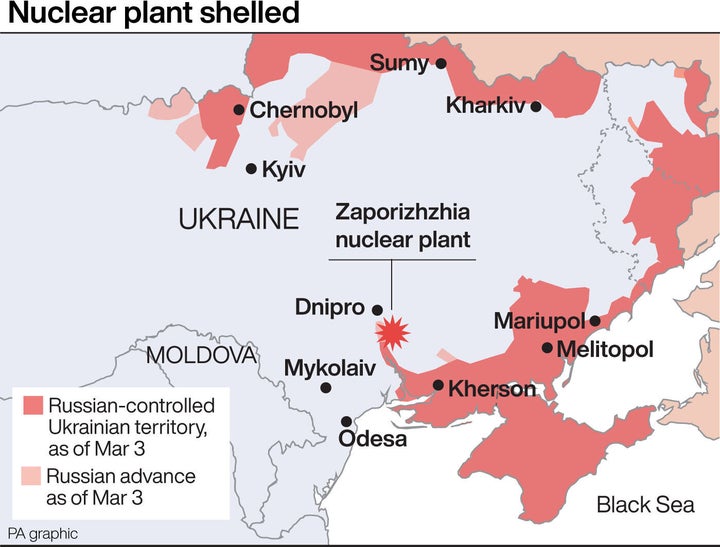
Russia’s latest act of violence against Ukraine was aimed at the largest nuclear power plant in Europe, Zaoporizhzhia, on Thursday night.
The plant, home to six of Ukraine’s 15 nuclear reactors, was shelled repeatedly during an intense battle. It set off a fire in a nearby building which, luckily, did not reach the critical infrastructure.
Within three hours the fire was brought under control, but Russian troops still managed to seize the complex while Ukrainian technicians continue to staff the area.
The plant provides more than a fifth of the total electricity generated in Ukraine, which may be why it was targeted by the Russians as they attempted to further weaken the country’s major cities.
The attack could also have far-reaching consequences for both the war and Europe, according to Western leaders and the Ukrainian president.
So, how dangerous was this attack, and could it be a turning point in the war?

How much damage did the attack actually cause?
Ukrainian foreign minister Dmytro Kuleba tweeted at the time of the attack that if an explosion were to occur, it would be “10 times larger than Chernobyl”, the 1986 accident which was the worst nuclear disaster in history.
An exclusion zone remains around this area due to the nuclear contamination.
However, Thursday’s attack appears not to have triggered elevated radiation levels at the plant so far.
The head of the region’s military administration, Oleksandr Starukh, confirmed early Friday morning: “Nuclear safety is now guaranteed.”
How could it have been dangerous?
The shelling could have triggered a major radioactive release, contaminating the people, animals, air, water and environment around it.
But, addressing Kuleba’s comparison to the 1986 disaster, retired nuclear scientist Cheryl Rofer tweeted: “None of the reactors at Zaporizhzhia [are] likely to explode in the way Chernobyl did.”
She said this site not only has different reactors to the ones in Chernobyl, but that site had a “particular flaw that led to its explosion”.
However, she still urged the Russians to move away from the plant, because any accidents could trigger loss of power and overheating.
The main thing to prevent explosion would be making sure the reactors are cool.
Former nuclear security adviser to Joe Biden, Jon Wolfstal, also pointed out that the reactors (VVER to Chernobyl’s RBMK) are much safer.
He said that these RBMK systems would enter a safe state even when they stop working.
Wolfstal pointed out that the main danger comes from whether the buildings around the reactors are damaged, as this could affect the safety systems.
“If the containment vessel is undamaged and if secondary or outside power is in place or can be restored, then there should be little risk.
“But it is massively irresponsible for Russia to have taken any action that put this plant at risk,” he said.
Why are world leaders so worried?
Disaster seemed to have been averted, but world leaders are still concerned about what this means for the general direction of the war.
It’s not clear if the Russians intended to attack it, or if they might cause a radioactive release later or even how big it might be.
The Ukrainian president has since accused Putin of “nuclear terror” in a video statement.
Volodymyr Zelenskyy said: “No country other than Russia has ever fire on nuclear power units. This is the first time in our history. In the history of mankind.”
He also said that “Europe must wake up”, as an explosion would be “the end of all of us”.
Zelenskyy also warned that there was the threat of mine explosions now at Putin’s disposal, not to mention the ability to blackmail world leaders with nuclear disaster.
The Ukrainian authorities had actually been calling for the UN’s atomic watchdog to set up a 30km perimeter ban around Zaporizhzhia and similar plants for some time. They hoped to have this reinforced Nato-backed no-fly zone above it, to prevent Russian invasion, conscious that this would be a turning point in the war.
Prime minister Boris Johnson also called an emergency UN Security Council meeting immediately afterwards to discuss the crisis, before warning the public that Putin was “directly threatening the safety of all of Europe” after the attack.
“An affront to the world at large”
- Dominic Raab, deputy prime minister
Deputy prime minister Dominic Raab dubbed it a “reckless” attack which was “doubly reprehensible” as Russian forces continued trying to shell it after the emergency services tried to put it out.
Raab said the world needed to “come down hard on Putin” as a result, because the nuclear implications are “an affront to the world at large”.
It’s worth noting that the nuclear energy company behind all four of Ukraine’s power stations, Energoatom, has warned that statements from managers at the plant may have been made under the watchful eye of the Russian troops.
It claimed: “There is a high probability that the recent speech of the mayor of Enerhodar was recorded under the barrel of a machine gun.”
So even though it looks as though Zaoporizhzhia is now safe, there are fears the West does not have the full picture.
What will Putin do next?
It’s hard to know what Vladimir Putin is thinking, and if he wanted to target the nuclear reactors at all.
On Friday, he even said in a press conference that Russia has “no ill intentions towards its neighbours” and called for international cooperation to return to normal – which seems unlikely, now he’s been accused of war crimes in Ukraine.
Writing in Bloomberg, Tyler Cowen speculated that Putin is only wanting to show he is not afraid of nuclear attacks, without actually risking retaliation and escalation from the West. But right now, the Russian president’s military plan is far from clear.

